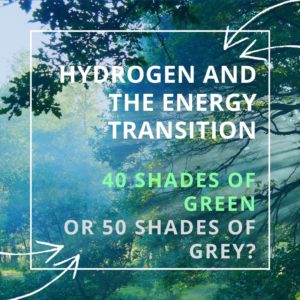Hydrogen and the Energy Transition: 40 Shades of Green or 50 Shades of Grey
In Europe and around the world, hydrogen is increasingly seen as an important part of the energy transition. Industry and political actors believe it can help decarbonise transport, heating and industry. But is hydrogen really the zero-carbon miracle solution that will play a pivotal role in Europe's decarbonisation?
 In Europe and around the world, hydrogen is increasingly seen as an important part of the energy transition. Industry and political actors believe it can help decarbonise transport, heating and industry. But is hydrogen really the zero-carbon miracle solution that will play a pivotal role in Europe’s decarbonisation?
In Europe and around the world, hydrogen is increasingly seen as an important part of the energy transition. Industry and political actors believe it can help decarbonise transport, heating and industry. But is hydrogen really the zero-carbon miracle solution that will play a pivotal role in Europe’s decarbonisation?
A zero-carbon energy carrier?
The first claim made about hydrogen is that it is zero- or low-carbon. And while it’s true that hydrogen does not produce CO2 when its burned, 96% of the hydrogen produced in the world today is made using fossil fuels, in processes that emit both carbon dioxide and methane.
Hydrogen that is made with coal or fossil gas is known as ‘grey” hydrogen, as it emits large amounts of CO2. There are efforts to make this hydrogen low-carbon by using carbon capture and storage/utilisation (CCS/U) technologies to produce so-called ‘blue’ hydrogen. CCS takes the carbon dioxide that is a by-product of hydrogen production from fossil fuels and stores it in underground reservoirs, whereas CCU takes the CO2 and uses it again – primarily in oil extraction and fertilisers.
The problem is that these technologies are unproven, and many pilot projects have struggled or failed. The flagship projects that do exist have very low capture rates (sometimes as low as 33%), and even a perfectly operating CCS/U installation would not be able to capture the full amount of CO2 emitted during hydrogen production. And CCS/U does nothing to limit the emissions of methane from the fossil gas used to produce hydrogen in the first place. Methane is so damaging to the climate that even a small amount of emissions can turn fossil gas into a fuel entirely incompatible with the Paris Agreement.
The only truly sustainable source of hydrogen is ‘green’ hydrogen, which is produced from renewable energy through a process called electrolysis.
Banking on green hydrogen?
With some actors recognising that grey and blue hydrogen are incompatible with the EU’s climate targets, they are increasingly putting their faith in green hydrogen. Supporters say that it can be used in heating, transport, industry and even electricity generation. This is technically true, but there will not be enough green hydrogen available to service all these sectors simultaneously.
Green hydrogen is expensive to produce, and could pose other issues. If there is no dedicated energy generation to feed electrolysers directly, these systems would rely on excess renewable energy during particularly windy or sunny periods, which are times when the electricity that is produced often exceeds demand for homes, businesses and transport. In using excess renewable electricity, green hydrogen production can play a role in compensating for the variability of renewables.
However, it also means that only limited amounts of green hydrogen can be produced. This will have to be allocated to the areas where it is needed most. For heating homes and powering cars, electricity is much more efficient than hydrogen. However, for industrial processes or long-distance shipping that cannot be easily electrified, green hydrogen can play a crucial role in decarbonisation. This would require careful planning to ensure that green hydrogen goes to the sectors that need it most and is not wasted in sectors that can be easily electrified, or where energy efficiency measures can dramatically reduce energy demand.
Importance of planning for the hydrogen future
Green hydrogen will be produced in very different places, and used in very different sectors, compared to where fossil gas is used today. That means that pipelines and LNG infrastructure cannot be used for both gases. While there might be some overlap between current gas and future hydrogen transport routes, the notion that fossil gas infrastructure built today is “multi-purpose” and can be used for green hydrogen in the future is misguided. But this deceptive argument is already being used by politicians and energy system operators to justify continued support for fossil gas.
Green hydrogen can play an important role in the energy transition, but not if it is used as camouflage for the continued use of fossil fuels.


